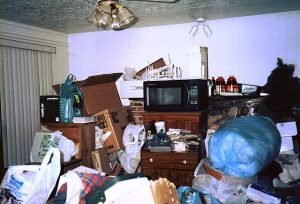6 Compulsive Hoarding Disorder
Learning Objectives
- Identify and describe gambling, overeating, and hoarding behavioral addiction and corresponding symptoms.
- Utilize and research SAMHSA Guidelines for identification and treatment of behavioral addictions.
- Utilize DSM – 5 TR for diagnosis and research of criterion to treat behavioral addictions.
 overview of compulsive hoarding disorder
overview of compulsive hoarding disorder
Compulsive Hoarding disorder is characterized by a compulsion or need to keep items, even items that are of no value, not useful, or detrimental to the health of the person hoarding and others in the household. People suffering from compulsive hoarding disorder will hoard numerous items, sometimes, they will even collect and hoard animals. There are “neat” or “filthy” hoards, with varying degrees in between. Nearly all cases of CHD result in property damage to the structures of their homes, and often times, city or government officials will condemn the property until it is cleaned up to the code enforcement’s order. Some people with CHD are aware that they have a problem, while others do not see anything wrong with their behaviors. Compulsive Hoarding affects up to 5 percent of the U.S. Population and continues to affect members and their families (Frost & Steketee, 2014).
DSM-5: Hoarding Disorder |
|---|
| Disorder Class: Obsessive-Compulsive and Related Disorders |
| Persistent difficulty discarding or parting with possessions, regardless of their actual value. |
| This difficulty is due to a perceived need to save the items and to the distress associated with discarding them. |
| The difficulty discarding possessions results in the accumulation of possessions that congest and clutter active living areas and substantially compromises their intended use. If living areas are uncluttered, it is only because of the interventions of third parties (e.g., family members, cleaners, or the authorities). |
| The hoarding causes clinically significant distress or impairment in social, occupational, or other important areas of functioning (including maintaining a safe environment safe for oneself or others). |
| The hoarding is not attributable to another medical condition (e.g., brain injury, cerebrovascular disease, Prader-Willi syndrome). |
| The hoarding is not better explained by the symptoms of another mental disorder (e.g., obsessions in obsessive-compulsive disorder, decreased energy in major depressive disorder, delusions in schizophrenia or another psychotic disorder, cognitive defects in major neurocognitive disorder, restricted interests in autism spectrum disorder). |
treatment for compulsive hoarding disorder
Cognitive Behavioral Therapy (CBT) is highly recommended to treat CHD. This treatment examines the underlying thoughts and feelings for why a patient desires to hoard, and works to change the way they think about the objects that they hoard. Working with a licensed CBT therapist is the goal for treatment, along with support provided to members of the family and community (Weir, 2020). While CBT is helpful, it may not always “cure” the patient, as they may relapse or fail to continue with CBT therapy. In this case, other types of therapy may need to be explored to address the root cause of the behavior. In some cases, trauma is the underlying impetus for CHD. Psychoanalysis and psychotherapy may help the patient to understand their trauma behavior, and why they continue to hoard objects that are of little or no value, and in some cases, are far more detrimental to keep.
For Further Discussion
1. Do you think those that suffer from Hoarding disorder have underlying mental health issues?
2. If you had a family member or friend that hoarded excessively, to the point that the house was unsafe to live in, would you confront them? Why or why not?
3. Do you think Hoarding runs in families (genetically speaking)?
supplemental video
Additional resources
https://www.apa.org/education-career/ce/hoarding-disorder.pdf
https://hoarding.iocdf.org/professionals/
https://www.sciencedirect.com/science/article/abs/pii/S0165032719301521
